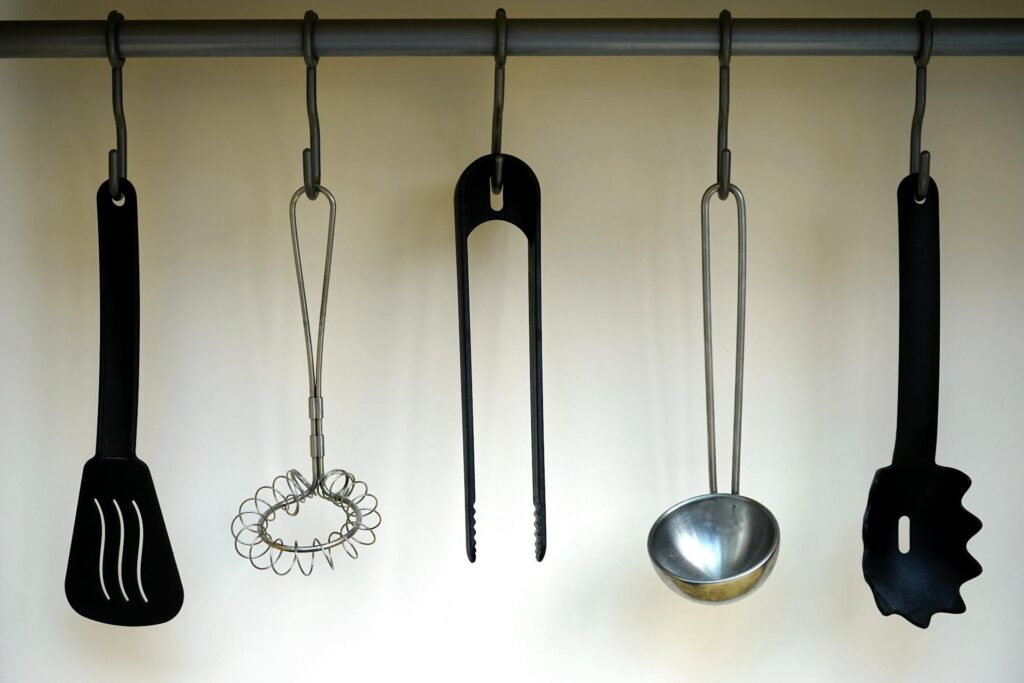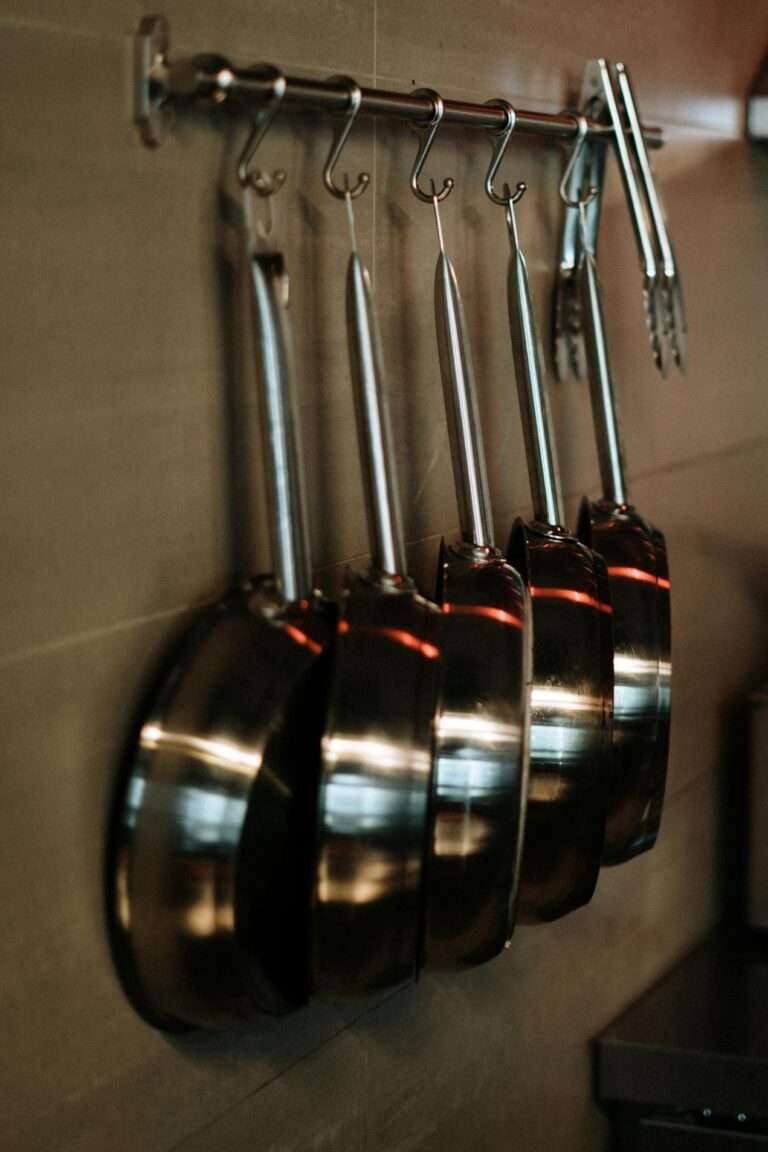Finding the right way to store kitchen utensils can transform how smoothly your cooking routine flows. When your tools have a designated spot, you spend less time digging through drawers and more time actually cooking. These storage methods can work whether you have a sprawling kitchen or a compact cooking space.

Why Kitchen Utensil Storage Matters
The way you organize cooking utensils can influence how smoothly your kitchen functions. Cluttered counters can make meal prep frustrating, while thoughtful utensil organization keeps your tools within easy reach.
A well-organized kitchen can also help protect your tools from damage. Tossing utensils into overstuffed drawers can dull knives, bend spatulas, and create a tangled mess.
1. Use Drawer Dividers to Separate Kitchen Utensils by Type
Drawer dividers create dedicated sections for each type of tool. This approach can help keep spatulas separate from whisks and prevent that chaotic jumble where things tangles together.
Adjustable dividers work well since they fit different drawer sizes. Place your most-used tools in the front sections for quick access during cooking.
Measure your drawer depth before buying dividers. Some organizers sit too tall and prevent drawers from closing properly.
2. Install a Wall-Mounted Rail to Store Kitchen Utensils Near the Stove
A mounted rail keeps frequently used tools right where you need them. Hang S-hooks from the rail to hold spatulas, ladles, and tongs within arm’s reach of your cooking surface.
This kitchen tool storage method can free up drawer and counter space. You can grab what you need without opening cabinets or rummaging through containers.
Position the rail 6-8 inches above your countertop. Any higher can make it awkward to reach, any lower can crowd your workspace.
Also read: How to Remove Burnt-On Residue From Stove Tops
3. Place a Countertop Crock to Store Kitchen Utensils You Use Daily

A simple crock or utensil holder on your counter keeps everyday tools visible and accessible. This approach works particularly well for wooden spoons, spatulas, and serving utensils that you reach for multiple times each day.
Choose a weighted base to prevent tipping when you pull tools out quickly. Ceramic or stoneware crocks provide stability that lightweight containers lack.
Group similar utensils together within the crock. Keep stirring tools on one side and serving pieces on the other for easier selection.
4. Add Pegboard Storage to Organize Kitchen Tools Vertically
Pegboard turns empty wall space into functional utensil storage. You can customize the hook placement to fit your specific tools and rearrange them as your collection changes.
This solution works well in small kitchens where drawer space is limited. The vertical storage can keep items visible while maintaining an organized appearance.
5. Use Magnetic Strips to Store Kitchen Utensils with Metal Handles
Magnetic strips mounted under cabinets or on walls can hold metal utensils securely. This approach works for anything with a magnetic component, from knives to metal measuring spoons.
The tools hang in plain sight, which can make it easier to spot what you need. Magnetic storage also allows utensils to dry properly between uses, helping prevent moisture buildup.
Test the magnet strength before mounting. Weaker strips might not support heavier tools like cast iron implements or large chef’s knives.
6. Organize Kitchen Utensils in Deep Drawers with Tiered Inserts
Deep drawers can become difficult to navigate where tools get lost at the bottom. Tiered inserts create multiple levels that can keep things visible and prevent smaller items from sinking down.
This kitchen utensil storage method can maximize vertical space within drawers. You might fit more tools while still seeing each item clearly.
Place heavier utensils on the bottom tier. Lighter tools on top won’t get crushed and remain easy to grab.
7. Install Pull-Out Cabinet Organizers to Store Kitchen Utensils Efficiently
Pull-out organizers bring your utensils forward instead of making you reach into dark cabinet corners. These sliding systems can work well for storing larger cooking tools like rolling pins and whisks.
The full extension allows you to see everything at once. You’re less likely to forget about tools shoved in the back of cabinets.
Measure your cabinet interior carefully. Pull-out systems need adequate clearance to function smoothly without catching on shelves or doors.
Also read: 6 Cabinet Hacks for Small Kitchens
8. Designate a Kitchen Utensil Drawer Near Your Primary Prep Area
A single dedicated drawer positioned near where you do most of your prep work can help streamline your cooking process. This centralized approach means you might walk back and forth across the kitchen less often for different tools.
Keep only actively used items in this spot. Specialty utensils that see occasional use can live in less accessible locations.
Review this drawer quarterly. Tools you haven’t touched in months probably don’t need premium placement.
Mistakes to Avoid When Organizing Cooking Utensils
Overcrowding containers or drawers can work against your organization efforts. When you cram too many tools into one space, you might end up digging and searching again.
Leave breathing room between items. This can make selection faster and help protect tools from damage.
Avoid storing wet utensils immediately after washing. Trapped moisture can lead to rust, warping, and unpleasant odors that settle into wooden tools.
Questions & Answers
How do you organize utensils in a small kitchen?
Vertical storage solutions work well in compact spaces. Wall-mounted rails, magnetic strips, and pegboards keep utensils accessible without consuming precious counter or drawer real estate.
Focus on storing only the tools you actually use regularly.
What is a good way to store cooking utensils?
A practical kitchen tool storage approach depends on your cooking habits and available space. Countertop crocks suit utensils you grab multiple times daily, while drawer dividers work well for tools used less frequently.
Combine multiple methods for optimal organization. Use drawers for backups and specialty items, while keeping everyday tools on display.
Where should you store kitchen utensils for easiest access?
Store kitchen utensils within the “work triangle” between your stove, sink, and main prep surface. This positioning can minimize steps during cooking and help make meal preparation more efficient.
How do you keep kitchen utensils from cluttering counters?
Designate specific storage spots for every utensil rather than letting them pile up randomly. When each tool has a home, putting items away can become more automatic.
Limit countertop storage to 5-7 daily-use items. Everything else should live in drawers, cabinets, or wall-mounted organizers.
What should you not store with kitchen utensils?
Keep sharp knives separate from other utensils to help prevent dulling and accidents. Dedicated knife blocks or magnetic strips can provide safer storage than mixed utensil drawers.
Avoid storing food items like wooden cutting boards in the same drawer as utensils. Different cleaning requirements can make this combination impractical.
How often should you reorganize kitchen utensil storage?
Review your utensil organization every 3-4 months to identify what’s working and what needs adjustment. Cooking habits usually change seasonally, and your storage should adapt accordingly.
Immediately address any system that’s creating frustration. If you’re constantly digging for tools or leaving items on the counter, the current setup isn’t serving you.
Can you store all types of kitchen utensils together?
Grouping by function tends to work better than storing everything together. Keep stirring tools separate from measuring implements and serving pieces from prep utensils.
Similar shapes and sizes can share space effectively. Spatulas of various types fit well together, while bulky items like mashers might need more room.
What type of drawer organizers work well for kitchen utensils?
Adjustable bamboo or plastic dividers offer flexibility for different drawer sizes and utensil collections. These organizers let you create custom compartments that fit your specific needs.
Look for organizers with non-slip bases that stay put when you open and close drawers.
Make Your Kitchen Work Better
Finding the right way to store kitchen utensils can help simplify your daily cooking routine and keep your space functional. Start with one method that addresses your biggest frustration, whether that’s cluttered counters or overstuffed drawers.
Your organizational needs might evolve as your cooking style changes. Stay flexible and adjust your storage solutions when something stops working well.

